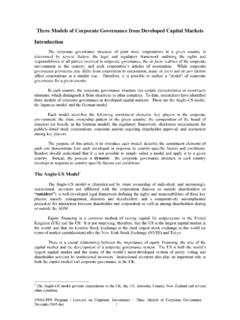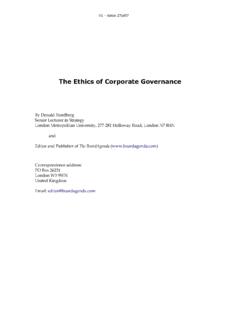Transcription of Corporate Governance – Concepts and Issues - IOD
1 Corporate Governance Concepts and Issues Sreeti Raut Sreeti Raut is holding a Master's Degree in Business Administration focusing on Finance and Insurance &. Risk Management, Presently, she is a Research Scholar with Institute of Directors, India Introduction Corporate Governance is a process that aims to allocate Corporate resources in a manner that maximizes value for all stakeholders shareholders, investors, employees, customers, suppliers, environment and the community at large and holds those at the helms to account by evaluating their decisions on transparency, inclusivity, equity and responsibility. The World Bank defines Governance as the exercise of political authority and the use of institutional resources to manage society's problems and affairs.
2 Corporate Governance is the set of processes, customs, policies, laws, and institutions affecting the way a corporation (or company) is directed, administered or controlled. Corporate Governance also includes the relationships among the many stakeholders involved and the goals for which the corporation is governed. In contemporary business corporations, the main external stakeholder groups are shareholders, debt holders, trade creditors, suppliers, customers and communities affected by the corporation's activities. Internal stakeholders are the board of directors, executives, and other employees. There are many different models of Corporate Governance around the world. These differ according to the variety of capitalism in which they are embedded.
3 The Anglo-American "model" tends to emphasize the interests of shareholders. The coordinated or multi-stakeholder model associated with Continental Europe and Japan also recognizes the interests of workers, managers, suppliers, customers, and the community. Legal environment Corporations are created as legal persons by the laws and regulations of a particular jurisdiction. These may vary in many respects between countries, but a corporation's legal person status is fundamental to all jurisdictions and is conferred by statute. This allows the entity to hold property in its own right without reference to any particular real person. It also results in the perpetual existence that characterizes the modern corporation.
4 The statutory granting of Corporate existence may arise from general purpose legislation (which is the general case) or from a statute to create a specific corporation, which was the only method prior to the 19th century. In addition to the statutory laws of the relevant jurisdiction, corporations are subject to common law in some countries, and various laws and regulations affecting business practices. In most jurisdictions, corporations also have a constitution that provides individual rules that govern the corporation and authorize or constrain its decision-makers. This constitution is identified by a variety of terms; in English- speaking jurisdictions, it is usually known as the Corporate Charter or the [Memorandum and] Articles of Association.
5 The capacity of shareholders to modify the constitution of their corporation can vary substantially. Codes and guidelines Corporate Governance principles and codes have been developed in different countries and issued from stock exchanges, corporations, institutional investors, or associations (institutes) of directors and managers with the support of governments and international organizations. As a rule, compliance with these Governance recommendations is not mandated by law, although the codes linked to stock exchange listing requirements may have a coercive effect. For example, companies quoted on the London, Toronto and Australian Stock Exchanges formally need not follow the recommendations of their respective codes.
6 However, they must disclose whether they follow the recommendations in those documents and, where not, they should provide explanations concerning divergent practices. Such disclosure requirements exert a significant pressure on listed companies for compliance. One of the most influential guidelines has been the 1999 OECD Principles of Corporate Governance . This was revised in 2004. The OECD guidelines are often referenced by countries developing local codes or guidelines. Building on the work of the OECD, other international organizations, private sector associations and more than 20 national Corporate Governance codes, the United Nations Intergovernmental Working Group of Experts on International Standards of Accounting and Reporting (ISAR) has produced their Guidance on Good Practices in Corporate Governance Disclosure.
7 This internationally agreed benchmark consists of more than fifty distinct disclosure items across five broad categories: Auditing Board and management structure and process Corporate responsibility and compliance Financial transparency and information disclosure Ownership structure and exercise of control rights The World Business Council for Sustainable Development WBCSD has done work on Corporate Governance , particularly on accountability and reporting, and in 2004 released Issue Management Tool: Strategic challenges for business in the use of Corporate responsibility codes, standards, and frameworks. This document offers general information and a perspective from a business association/think-tank on a few key codes, standards and frameworks relevant to the sustainability agenda.
8 In 2009, the International Finance Corporation and the UN Global Compact released a report, Corporate Governance - the Foundation for Corporate Citizenship and Sustainable Business', linking the environmental, social and Governance responsibilities of a company to its financial performance and long- term sustainability. Most codes are largely voluntary. An issue raised in the since the 2005 Disney decision is the degree to which companies manage their Governance responsibilities; in other words, do they merely try to supersede the legal threshold, or should they create Governance guidelines that ascend to the level of best practice. For example, the guidelines issued by associations of directors, Corporate managers and individual companies tend to be wholly voluntary but such documents may have a wider effect by prompting other companies to adopt similar practices.
9 In the United States, corporations are directly governed by state laws, while the exchange (offering and trading) of securities in corporations (including shares) is governed by federal legislation. Many states have adopted the Model Business Corporation Act, but the dominant state law for publicly-traded corporations is Delaware, which continues to be the place of incorporation for the majority of publicly- traded corporations. Individual rules for corporations are based upon the Corporate charter and, less authoritatively, the Corporate bylaws. Shareholders cannot initiate changes in the Corporate charter although they can initiate changes to the Corporate bylaws. US expansion after World War II through the emergence of multinational corporations saw the establishment of the managerial class.
10 According to Lorsch and MacIver "many large corporations have dominant control over business affairs without sufficient accountability or monitoring by their board of directors." Over the past three decades, Corporate directors' duties in the have expanded beyond their traditional legal responsibility of duty of loyalty to the corporation and its shareholders. In the first half of the 1990s, the issue of Corporate Governance in the received considerable press attention due to the wave of CEO dismissals ( : IBM, Kodak, Honeywell) by their boards. The California Public Employees' Retirement System (CalPERS) led a wave of institutional shareholder activism, as a way of ensuring that Corporate value would not be destroyed by the now traditionally cozy relationships between the CEO and the board of directors.








